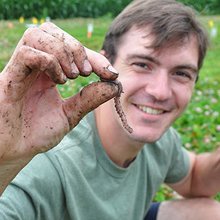Soil surrounds us, lying just under our feet, but there is still much we don’t know about the living soil. Soil contains billions of living organisms, from worms and insects to microscopic fungi and bacteria. It’s one of the most diverse ecosystems on earth. This “living” soil plays a vital part in our ecosystems and food production and students and researchers here at the Department of Soil, Water, and Climate and seeking to understand and leverage the power of healthy soil.

Assistant Professor Jessica Gutknecht is always on the hunt for those tiny organisms living in the soil.
“Soil is alive and absolutely amazing. A healthy soil absorbs and stores more water, cleans water, and might even take significant amounts of carbon from the atmosphere and store it,” says Gutknecht. “Healthy soils also improve the ability of farmers to grow crops with less inputs or with less worry about climate extremes such as drought or flooding. The more we learn, the more we can protect and keep our soils healthy, creating win-wins for farmers and our whole environment."
Gutknecht’s work focuses on those microbial communities in the soils of all sorts of systems across Minnesota. From working with the Minnesota NRCS on their Soil Health Initiative to build soil quality on Minnesota farms, to the international climate change experiment SPRUCE in the peat bogs of northern Minnesota, the one thing that ties the work together is the incredible role microbes play.

Jon Alexander, a graduate student in the Land and Atmospheric Science program, is looking for ways to improve the health of agricultural soils and maintain a prosperous agricultural community. He is currently working on a project using Kura clover as a perennial cover crop. Kura clover’s dense roots keep soil locked in place, preventing erosion. They also create routes for water to soak into the soil, reducing runoff. Well balanced microbial communities rely on the healthy and stable root system that kura clover can provide. This new cropping system may be an important tool for producers hoping to improve productivity, profitability, and soil health.
“Growing up on my families’ farm in Southwestern Minnesota, I have been a student of agriculture my entire life. Merging perspectives from my farm and academic backgrounds has been extremely beneficial. I hope that my work can bridge gaps between communities and promote fair, equitable, and sustainable agriculture in this great state.”
Soil Health Specialist Anna Cates is a new addition to the Department of Soil, Water, and Climate. As part of the Minnesota Office for Soil Health, her focus is on everything from research to sharing information with producers out in the field.
“Healthy soil is productive, and can absorb more water during big rains to store it for later for the plants to use. When you keep more water, soil, and nutrients in place, healthy soil can make a farm more resilient while providing cleaner water to the neighbors.”
Minnesota’s soils are incredibly diverse and Cates recognizes different practices will be needed in different areas and different soils – it’s not a one-size fits all system.
“Farmers are the cornerstone of thriving rural communities, and we hope to help them work within existing economic realities while being good stewards of the land. We’re aiming for the win-win of good stewardship and profit.”
This article was written by Stacy Nordstrom.
